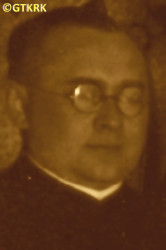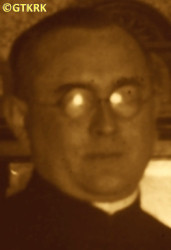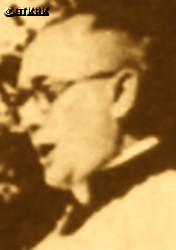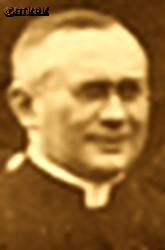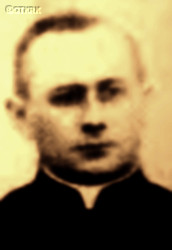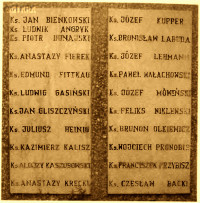Roman Catholic
St Sigismund parish
05-507 Słomczyn
85 Wiślana Str.
Konstancin deanery
Warsaw archdiocese, Poland
full list:
displayClick to display full list

searchClick to search full list by categories
wyświetlKliknij by wyświetlić pełną listę po polsku

szukajKliknij by przeszukać listę wg kategorii po polsku

Martyrology of the clergy — Poland
XX century (1914 – 1989)
personal data
surname
FITTKAU
forename(s)
Edmund
function
diocesan priest
creed
Latin (Roman Catholic) Church RCmore on
en.wikipedia.org
[access: 2014.09.21]
diocese / province
Culm (Chełmno) diocesemore on
pl.wikipedia.org
[access: 2012.11.23]
date and place
of death
11.1939

Wielka Piaśnicaknown as Piaśnica
today: Puck gm., Puck pov., Pomerania voiv., Poland
more on
en.wikipedia.org
[access: 2021.10.09]
alt. dates and places
of death
10.1939
details of death
In the years 1898‐1901 — during German occupation (Prussian partition of Poland) — while studying at the Germ. Königliches Katholisches Gymnasium (Eng. Royal Catholic Gymnasium) in Chełmno, participated in the activities of the Polish clandestine student self–education organization Pomeranian Philomaths. In 1901 the organization was discovered, the Germans expelled some of the students from school by, on 09‐12.09.1901 convicted some of them in a trial and abolished classes in Polish.
As a vicar in Gdańsk signed in c. 1906 a petition to allow religion classes in the local primary schools in Polish. Such petitions preceded a wave of school strikes in 1906‐1907, which were a reaction of Polish society to the removal of the Polish language from religious classes at the lowest level of education in Prussian schools. In the province of West Prussia (Germ. Provinz Westpreußen), students protested in 469 schools. Children „under written orders from their parents, refused to answer teachers' greetings in German or responded in Polish, remained silent when religious lessons were conducted in German, did not bring German textbooks and prayer books, or took their Polish equivalents with them. This happened despite the occupier's repression, fines, imprisonment, dismissal of parents from work, extension of compulsory schooling, transferring strikers to lower classes, not admitting their older siblings to junior high schools and colleges, etc. The Germans also used corporal punishment, as a result of which in In individual cases, disability and even death occurred. On the other hand, there were beatings of teachers, gendarmes and officials involved in suppressing strikes, and their apartments and schools were set on fire”.
After the end of World War I on 11.11.1918 (on that day, in Compiègne, in the HQ train of Marshal of France Ferdinand Foch, an armistice was signed between the Allies and Germany; on the same day, the Regency Council established by the Germans, operating in the area occupied by the Central States (Germany and Austro–Hungary) the so‐called Germ. Königreich Polen (Eng. Kingdom of Poland), transferred the supreme authority over the army to Brigadier Joseph Piłsudski and appointed him commander‐in‐chief of the Polish army, which de facto meant the rebirth of the Polish state; on the same day, in the territory of Poland directly incorporated into Prussia/Germany (partitions of Poland), the Polish People's Council was revealed in Poznań, renamed the Supreme People’s Council three days later) member of the County People's Council in Kamień, subordinate to the Supreme People's Council in Poznań.
After the German invasion of Poland on 01.09.1939 (the Russians attacked Poland 17 days later) and the start of World War II, arrested by the Germans on 12.09.1939, four days after the occupation of the city and the beginning of the occupation by the Germans. Treated prob. as a hostage, under threat of death, to guarantee the lack of Polish resistance to the invader. Jailed in Wejherowo prison. After a week released.
Arrested again on 20.10.1939, in the cemetery during a funeral conducted together with his vicar, Fr Bronislav Labuda.
Jailed in Puck prison, ZL Neufahrwasser camp and again in Wejherowo where from he was taken to an execution site.
Most of the arrested individuals were listed in the so‐called Germ. Sonderfahndungsliste (Eng. Special Wanted List), i.e. a proscription list of names of „enemies of the Reich”, prepared before the German aggression, who became victims of the genocidal Germ. «Intelligenzaktion» (Eng. Intelligentsia Action) plan, i.e. the extermination of Poland's intelligentsia and leadership.
The genocidal murders were carried out — in the Piaśnica Forest, c. 1 km from the center of the village of Wielka Piaśnica near Wejherowo in Pomerania, in a place today referred to as the „Pomeranian Katyn” or „Kashubian Golgotha” — by the paramilitary unit of the Germ. Die Schutzstaffel der NSDAP (Eng. NSDAP protection unit), i.e. SS, subordinate to the ruling National Socialist German Workers' Party NSDAP, e.g. from the Germ. SS‐Wachsturmbann „Eimann” (Eng. SS Guard and Assault Unit „Eimann”) unit, established on 03.07.1939 by the decree of the Senate of the Free City of Danzig, with the help of members of the genocidal, paramilitary organization Germ. Volksdeutscher Selbstschutz (Eng. Ethnic German Self‐Defense), i.e. treacherous citizens of the German minority in Poland.
The victims were usually transported by train to Wejherowo, in closed wagons attached to a regular commuter train. There, the wagons were detached and, after a brutal selection that included the separation of families and children, the victims were loaded onto trucks and buses. There, pits awaited them, first dug by local German farmers and later by Poles‐prisoners from the ZL Neufahrwasser camp in Gdańsk‐known as the „Himmelfahrtskommando” (Eng. „Ascension Commando”), who were murdered after some time, and new ones were brought in. The victims had to strip down to their underwear, and then, in groups of 5‐6, were murdered by a shot to the back of the head, while standing or kneeling over the dug pit. The wounded were finished off‐some with blows from rifle butts. Some of the children were murdered by smashing their heads against tree trunks. The graves were buried, and in 1940, tree and shrub seedlings were planted on them.
In total, from 10.1939 to 04.1940, the Germans murdered 12,000‐14,000 Poles from Gdańsk Pomerania in mass executions.
In 1944, facing the approaching German–Russian front and inevitable defeat, as part of the Germ. „Sonderaktion 1005” (Eng. „Special Action 1005”), groups of prisoners from the KL Stutthof concentration camp, referred to as Germ. „Leichenkommandos” (Eng. „Corpses' Units”) — under the supervision of Germans, members of the genocidal Germ. Sicherheitsdienst des Reichsführers SS (Eng. Security Service of the Reichsführer SS), i.e. «SD» — dug up the bodies of the murdered and burned them. The Germans then murdered the prisoners.
cause of death
mass murder
perpetrators
Germans
sites and events
PiaśnicaClick to display the description, ZL NeufahrwasserClick to display the description, PuckClick to display the description, WejherowoClick to display the description, «Intelligenzaktion»Click to display the description, Collective responsibility („Hostages”)Click to display the description, Reichsgau Danzig‐WestpreußenClick to display the description, Ribbentrop‐MolotovClick to display the description, Pius XI's encyclicalsClick to display the description, Pomeranian PhilomathsClick to display the description
date and place
of birth
11.04.1883

Bisztynektoday: Bisztynek gm., Bartoszyce pov., Warmia‐Masuria voiv., Poland
more on
en.wikipedia.org
[access: 2021.10.09]
parents
FITTKAU Joseph
🞲 ?, ? — 🕆 1886, ?

SKIBOWSKA Valerie
🞲 ?, ? — 🕆 ?, ?
presbyter (holy orders)
ordination
06.05.1906

positions held
1939
dean — Pucktoday: Puck gm., Puck pov., Pomerania voiv., Poland
more on
en.wikipedia.org
[access: 2021.07.18] RC deanery
1920 – 1939
parish priest — Pucktoday: Puck gm., Puck pov., Pomerania voiv., Poland
more on
en.wikipedia.org
[access: 2021.07.18] ⋄ St Peter and St Paul the Apostles RC parish ⋄ Pucktoday: Puck gm., Puck pov., Pomerania voiv., Poland
more on
en.wikipedia.org
[access: 2021.07.18] RC deanery — also: inspector of religious education in primary schools, president of local branches of the People's Library Society, Catholic Workers' Society, vice–president of the Polish Tourist Society in Puck (1921‐1925)
c. 1937 – 1939
membership — Pelplintoday: Pelplin gm., Tczew pov., Pomerania voiv., Poland
more on
en.wikipedia.org
[access: 2021.05.06] ⋄ Lat. „Consilium a Vigilantiae” (Eng. „Committee on Morals”), Diocesan Curia
1914 – 1920
chaplain — Kamień Pomorskitoday: Kamień Krajeński, Kamień Krajeński gm., Sępólno Krajeńskie pov., Pomerania voiv., Poland
more on
en.wikipedia.org
[access: 2021.09.02] ⋄ St Anne Correctional Institute ⋄ Blessed Virgin Mary and St Peter and St Paul the Apostles RC parish ⋄ Kamień Pomorskitoday: Kamień Krajeński, Kamień Krajeński gm., Sępólno Krajeńskie pov., Pomerania voiv., Poland
more on
en.wikipedia.org
[access: 2021.09.02] RC deanery
administrator — Subkowytoday: Subkowy gm., Tczew pov., Pomerania voiv., Poland
more on
en.wikipedia.org
[access: 2021.09.02] ⋄ St Stanislav the Bishop and Martyr RC parish ⋄ Tczewtoday: Tczew urban gm., Tczew pov., Pomerania voiv., Poland
more on
en.wikipedia.org
[access: 2021.09.02] RC deanery
vicar — Grudziądztoday: Grudziądz city pov., Kuyavia‐Pomerania voiv., Poland
more on
en.wikipedia.org
[access: 2021.09.02] ⋄ RC parish ⋄ Grudziądztoday: Grudziądz city pov., Kuyavia‐Pomerania voiv., Poland
more on
en.wikipedia.org
[access: 2021.09.02] RC deanery
vicar — Człuchówtoday: Człuchów gm., Człuchów pov., Pomerania voiv., Poland
more on
en.wikipedia.org
[access: 2021.09.02] ⋄ St James the Great the Apostle RC parish ⋄ Człuchówtoday: Człuchów gm., Człuchów pov., Pomerania voiv., Poland
more on
en.wikipedia.org
[access: 2021.09.02] RC deanery
vicar — Żarnowiectoday: Krokowa gm., Puck pov., Pomerania voiv., Poland
more on
en.wikipedia.org
[access: 2021.09.02] ⋄ Annunciation to the Blessed Virgin Mary RC parish ⋄ Pucktoday: Puck gm., Puck pov., Pomerania voiv., Poland
more on
en.wikipedia.org
[access: 2021.07.18] RC deanery
vicar — GdańskŚródmieście district
today: Gdańsk city pov., Pomerania voiv., Poland
more on
en.wikipedia.org
[access: 2022.02.24] ⋄ St Joseph RC parish ⋄ Gdańsk Ideanery name
today: Gdańsk city pov., Pomerania voiv., Poland
more on
en.wikipedia.org
[access: 2021.07.04] RC deanery
vicar — GdańskŚródmieście district
today: Gdańsk city pov., Pomerania voiv., Poland
more on
en.wikipedia.org
[access: 2022.02.24] ⋄ St Nicholas the Bishop and Confessor RC parish ⋄ Gdańsk Ideanery name
today: Gdańsk city pov., Pomerania voiv., Poland
more on
en.wikipedia.org
[access: 2021.07.04] RC deanery
1902 – 1906
student — Pelplintoday: Pelplin gm., Tczew pov., Pomerania voiv., Poland
more on
en.wikipedia.org
[access: 2021.05.06] ⋄ philosophy and theology, Theological Seminary
till 1902
pupil — Chełmnotoday: Chełmno urban gm., Chełmno pov., Kuyavia‐Pomerania voiv., Poland
more on
en.wikipedia.org
[access: 2021.07.25] ⋄ Germ. Königliche Katholische Gymnasium (Eng. Royal Catholic Gymnasium) — studies completed with the maturity diploma (i.e. matura)
pupil — Świecietoday: Świecie gm., Świecie pov., Kuyavia‐Pomerania voiv., Poland
more on
en.wikipedia.org
[access: 2021.09.02] ⋄ Germ. Königliche Progymnasium (Eng. Royal Progymnasium)
1907 – 1935
membership — Toruńtoday: Toruń city pov., Kuyavia‐Pomerania voiv., Poland
more on
en.wikipedia.org
[access: 2021.06.20] ⋄ scientific society
others related
in death
ANGRYKClick to display biography Louis, BIEŃKOWSKIClick to display biography John Anthony, BLAJERClick to display biography Blase, BŁAŻEWSKIClick to display biography Ignatius, BORYSIAKClick to display biography John, BRODOWSKIClick to display biography John, DUNAJSKIClick to display biography Peter Paul, FIEREKClick to display biography Anastasius, GASIŃSKIClick to display biography Louis, GLISZCZYŃSKIClick to display biography John, GŁOWAClick to display biography Ceslav, HEINIGClick to display biography Julius, HOEFTClick to display biography Walter Joseph, JAKUBOWSKIClick to display biography John Stanislav, JAMRÓGClick to display biography Witold (Fr Henry), JÓŹWIAKClick to display biography Joanna, KALISZClick to display biography Casimir Francis, KASZUBOWSKIClick to display biography Louis, KITZERMANNClick to display biography Francis, KNITTERClick to display biography Louis Bernard, KONEWECKIClick to display biography Joseph, KOTOWSKAClick to display biography Mary Hedwig (Sr Alice), KRĘCKIClick to display biography Anastasius John, LABUDAClick to display biography Bronislav, LEHMANNClick to display biography Joseph, MOJKOWSKIClick to display biography Julian, MÓWIŃSKIClick to display biography Joseph, NIKLEWSKIClick to display biography Felix Francis, OLKIEWICZClick to display biography Bruno, PRONOBISClick to display biography Adalbert, PRZYBYSZClick to display biography Francis, RACKIClick to display biography Ceslav, ROMPCAClick to display biography Leo, SARNOWSKIClick to display biography Robert Joseph, SUDYClick to display biography Charles, SZYNALEWSKIClick to display biography Francis Xavier Alex, SZYPNIEWSKIClick to display biography Vladislav, TURZYŃSKIClick to display biography Theodore Emilian, UGOFOWSKIClick to display biography Francis, WARCZAKClick to display biography Augustus, WĄTRÓBSKIClick to display biography Adalbert, WIELEWSKIClick to display biography Vladislav Silvester, WILEMSKIClick to display biography Ceslav Casimir, WILEMSKIClick to display biography Paul Felix, WITKOWSKIClick to display biography Boleslav, WOHLFEILClick to display biography Edmund Casimir, ZAKRZEWSKIClick to display biography John, ZĄBEKClick to display biography Edmund Leopold, ŻUREKClick to display biography Mieczyslav
sites and events
descriptions
Piaśnica: In the forests of Piaśnica, c. 1 km from the center of Wielka Piaśnica village near Wejherowo in Pomerania, as part of the Germ. «Intelligenzaktion», from 10.1939 to 04.1940, the Germans murdered, in mass executions, 12,000‐14,000 Poles from Gdańsk Pomerania, mostly Polish intelligentsia. Genocides were committed by SS units (including the Wachsturmbann „Eimann” unit) with the help of members of the paramilitary organization Volksdeutscher Selbstschutz, consisting of treacherous Polish citizens of German origin. Arrested people who found themselves on the one of the so‐called Germ. Sonderfahndungsliste (Eng. Special Wanted List), i.e. a proscription list of names of „enemies of the Reich”, prepared before the German aggression, or on some other proscription list, drawn up ad hoc by the local Germ. Volksdeutsche (Eng. Ethnic Germans), i.e. representatives of the German minority in Poland. The victims were usually transported by trains to Wejherowo, in closed wagons attached to a regular passenger services. There, the wagons were detached and the victims, after a brutal selection, with families and children separated, were loaded onto trucks and buses. There pits were awaiting them, dug out initially by local German farmers, and later by Polish‐prisoners from the Germ. Neufahrwasser camp in Gdańsk, known as the Germ. „Himmelfahrtskommando” (Eng. „Ascension into Heaven commando”) — these after some time were murdered and new ones were brought in. The victims had to undress to their underwear, and then in groups of 5‐6 people were murdered with a shot to the back of the head, standing or kneeling over a dug hole. The wounded were finished off — some with rifle butts. Some of the children were murdered by smashing their heads against tree trunks. The graves were then covered, and in 1940 seedlings of trees and bushes were planted on them. In 1944, facing the approaching German–Russian front and inevitable defeat, as part of the Germ. „Sonderaktion 1005” (Eng. „Special Action 1005”), groups of prisoners from the KL Stutthof concentration camp, referred to as Germ. „Leichenkommandos” (Eng. „Corpses' Units”) — under the supervision of Germans, members of the genocidal Germ. Sicherheitsdienst des Reichsführers SS (Eng. Security Service of the Reichsführer SS), i.e. «SD» — dug up the bodies of the murdered and burned them. The Germans then murdered the prisoners. Piaśnica is referred to as „Pomeranian Katyn” or „Kashubian Golgota”. (more on: en.wikipedia.orgClick to attempt to display webpage
[access: 2021.10.09])
ZL Neufahrwasser: Germ. Zivilgefangenenlager (Eng. POW camp for civilians) organized by the Germans on the day of the outbreak of the war, on 01.09. 1939, in Gdańsk ‐ Nowy Port (New Port), in former artillery barracks belonging to Poland, for Poles from Pomerania arrested as part of the «Intelligenzaktion» action — extermination of Polish intelligentsia. Prisoners from ZL Neufahrwasser — 2,702 people were identified, but it is estimated that c. 10,000 arrestees passed through the camp — were sent to the KL Stutthof concentration camp or directly to the places of extermination. The camp operated till 01.04.1940 (more on: stutthof.orgClick to attempt to display webpage
[access: 2013.08.10], ofiaromwojny.republika.plClick to attempt to display webpage
[access: 2013.12.04])
Puck: Detention centre run by Germans.
Wejherowo: A detention center built in c. 1877, taken over by the Germans after the German invasion of Poland on 01.09.1939. The first murders were committed there on 10.09.1939. In the detention center, designed for c. 300 people, the Germans held up to around 3,000 people — they were even held in the chapel and corridors. Among the detainees were Polish prisoners of war. In 1939, as part of the «Intelligenzaktion» — an action to exterminate Polish intelligentsia and leadership classes — the final selection of Poles brought by train was also carried out there, before being sent to the place of genocidal murders in Piaśnica. C. 2,000 prisoners from the detention center itself, detained in Wejherowo and nearby villages, were also taken there and murdered. (more on: www.sw.gov.plClick to attempt to display webpage
[access: 2013.08.17])
«Intelligenzaktion»: German: «Intelligenzaktion» (English: „Intelligence Action”) — a German program of extermination of the Polish elite, mainly the intelligentsia and leadership layers, carried out from the beginning of the occupation in w 09.1939 to 04.1940, mainly in territories directly annexed to Germany, but also in the so‐called Germ. Generalgouvernement (Eng. General Governorate), where it was called «AB‐aktion». In the first phase, immediately after the beginning of the German occupation, during military operations carried out by the Germ. Wehrmacht (Eng. Armed Forces) and the genocidal units of the Germ. Einsatzgruppen (Eng. Operational Groups) of the Germ. Sicherheitspolizei (Eng. Security Police), i.e. SiPo, and Germ. Sicherheitsdienst des Reichsführers SS (Eng. Security Service of the Reichsführer SS), i.e. SD, organized by the Germ. Reichssicherheitshauptamt (Eng. Reich Main Security Office), i.e. RSHA, which followed the troops, carried out under the Germ. Unternehmen „Tannenberg” (Eng. Operation „Tannenberg”) — based on the so‐called Germ. Sonderfahndungsliste (Eng. Special Wanted Lists), i.e. proscription lists of Poles considered particularly dangerous to the Third Reich, prepared by the Zentralstelle II/P (Polen) unit of the German RSHA. Later, implemented by the German civilian occupation authorities and the genocidal unit of the Germ. Volksdeutscher Selbstschutz (Eng. Ethnic Germans Self‐Defense), whose members were Germ. Volksdeutsche (Eng. Ethnic Germans), i.e. representatives of the German minority in Poland. According to various sources, these lists, at the beginning of 09.1939, could have contained the details of 61,000—88,000 „dangerous” Poles — although these figures cannot be confirmed. In total, during this genocide, c. 50,000 teachers, Catholic priests, representatives of the landed gentry, freelancers, social and political activists, and retired military personnel were systematically and methodically murdered. Another 50,000 were sent to concentration camps, where only a negligible percentage survived. (more on: en.wikipedia.orgClick to attempt to display webpage
[access: 2014.10.04])
Collective responsibility („Hostages”): A criminal practice implemented by the Germans in the occupied territories of Poland, applied from the very first day of World War II. At its core was an appointment and public announcement of a list of names of selected people whose lives depended on absolute compliance with German orders. Any violation of these ordinances, by any person, regardless of the circumstances, resulted in the murder of the designated „hostages”. In the first days of the war and occupation, it was used i.a. by the German Wehrmacht army to prevent acts of continuation of the defense by the Poles. Later, especially in the German‐run General Governorate, it was part of the official policy of the occupation authorities — collective responsibility for any acts of resistance to the occupier's practices. For the life of one German, even if death was due to customary reasons, the Germans carried out executions from a dozen to even a hundred Poles previously designated as „hostages”.
Reichsgau Danzig‐Westpreußen: After the Polish defeat in the 09.1939 campaign, which was the result of the Ribbentrop‐Molotov Pact and constituted the first stage of World War II, and the beginning of German occupation in part of Poland (in the other, eastern part of Poland, the Russian occupation began), the Germans divided the occupied Polish territory into five main regions (and a few smaller). The largest one was transformed into Germ. Generalgouvernement (Eng. General Governorate), intended exclusively for Poles and Jews and constituting part of the so‐called Germ. Großdeutschland (Eng. Greater Germany). Two were added to existing German provinces. From two other separate new provinces were created. Vistula Pomerania region was one of them, incorporated into Germany on 08.10.1939, by decree of the German leader Adolf Hitler (formally came into force on 26.10.1939), and on 02.11.1939 transformed into the Germ. Reichsgau Danzig‐Westpreußen (Eng. Reich District of Gdańsk‐West Prussia) province, in which the law of the German state was to apply. The main axis of the policy of the new province, the territory of which the Germans recognized as the Germ. „Ursprünglich Deutsche” (Eng. „natively German”), despite the fact that 85% of its inhabitants were Poles, was Germ. „Entpolonisierung” (Eng. „Depolonisation”), i.e. forced Germanization. C. 60,000 Poles were murdered in 1939‐1940, as part of the Germ. „Intelligenzaktion”, i.e. extermination of Polish intelligentsia and ruling classes, in c. 432 places of mass executions — including c. 220 Polish Catholic priests. The same number were sent to German concentration camps, from where few returned (over 300 priests were arrested, of whom c. 130 died in concentration camps). C. 124,000‐170,000 were displaced, including c. 90,000 to the Germ. Generalgouvernement. Poles were forced en masse to sign the German nationality list, the Germ. Deutsche Volksliste DVL. Polish children could only learn in German. It was forbidden to use the Polish language during Catholic Holy Masses and during confession. Polish landed estates were confiscated..To further reduce the number of the Polish population, Poles were sent to forced labor deep inside Germany. The remaining Poles were treated as low‐skilled labor, isolated from the Germans and strictly controlled — legally, three or three of them could only meet together, even in their own apartments. Many were conscripted into the German Wehrmacht army. After the end of hostilities of World War II, the overseer of this province, the Germ. Reichsstatthalter (Eng. Reich Governor) and the Germ. Gauleiter (Eng. district head) of the German National Socialist Party, Albert Maria Forster, was executed. (more on: en.wikipedia.orgClick to attempt to display webpage
[access: 2024.06.24])
Ribbentrop‐Molotov: Genocidal Russian‐German alliance pact between Russian leader Joseph Stalin and German leader Adolf Hitler signed on 23.08.1939 in Moscow by respective foreign ministers, Mr. Vyacheslav Molotov for Russia and Joachim von Ribbentrop for Germany. The pact sanctioned and was the direct cause of joint Russian and German invasion of Poland and the outbreak of the World War II in 09.1939. In a political sense, the pact was an attempt to restore the status quo ante before 1914, with one exception, namely the „commercial” exchange of the so‐called „Kingdom of Poland”, which in 1914 was part of the Russian Empire, fore Eastern Galicia (today's western Ukraine), in 1914 belonging to the Austro‐Hungarian Empire. Galicia, including Lviv, was to be taken over by the Russians, the „Kingdom of Poland” — under the name of the General Governorate — Germany. The resultant „war was one of the greatest calamities and dramas of humanity in history, for two atheistic and anti‐Christian ideologies — national and international socialism — rejected God and His fifth Decalogue commandment: Thou shall not kill!” (Abp Stanislav Gądecki, 01.09.2019). The decisions taken — backed up by the betrayal of the formal allies of Poland, France and Germany, which on 12.09.1939, at a joint conference in Abbeville, decided not to provide aid to attacked Poland and not to take military action against Germany (a clear breach of treaty obligations with Poland) — were on 28.09.1939 slightly altered and made more precise when a treaty on „German‐Russian boundaries and friendship” was agreed by the same murderous signatories. One of its findings was establishment of spheres of influence in Central and Eastern Europe and in consequence IV partition of Poland. In one of its secret annexes agreed, that: „the Signatories will not tolerate on its respective territories any Polish propaganda that affects the territory of the other Side. On their respective territories they will suppress all such propaganda and inform each other of the measures taken to accomplish it”. The agreements resulted in a series of meeting between two genocidal organization representing both sides — German Gestapo and Russian NKVD when coordination of efforts to exterminate Polish intelligentsia and Polish leading classes (in Germany called «Intelligenzaktion», in Russia took the form of Katyń massacres) where discussed. Resulted in deaths of hundreds of thousands of Polish intelligentsia, including thousands of priests presented here, and tens of millions of ordinary people,. The results of this Russian‐German pact lasted till 1989 and are still in evidence even today. (more on: en.wikipedia.orgClick to attempt to display webpage
[access: 2015.09.30])
Pius XI's encyclicals: Facing the creation of two totalitarian systems in Europe, which seemed to compete with each other, though there were more similarities than contradictions between them, Pope Pius XI issued in 03.1937 (within 5 days) two encyclicals. In the „Mit brennender Sorge” (Eng. „With Burning Concern”) published on 14.03.1938, condemned the national socialism prevailing in Germany. The Pope wrote: „Whoever, following the old Germanic‐pre‐Christian beliefs, puts various impersonal fate in the place of a personal God, denies the wisdom of God and Providence […], whoever exalts earthly values: race or nation, or state, or state system, representatives of state power or other fundamental values of human society, […] and makes them the highest standard of all values, including religious ones, and idolizes them, this one […] is far from true faith in God and from a worldview corresponding to such faith”. On 19.03.1937, published „Divini Redemptoris” (Eng. „Divine Redeemer”), in which criticized Russian communism, dialectical materialism and the class struggle theory. The Pope wrote: „Communism deprives man of freedom, and therefore the spiritual basis of all life norms. It deprives the human person of all his dignity and any moral support with which he could resist the onslaught of blind passions […] This is the new gospel that Bolshevik and godless communism preaches as a message of salvation and redemption of humanity”… Pius XI demanded that the established human law be subjected to the natural law of God , recommended the implementation of the ideal of a Christian state and society, and called on Catholics to resist. Two years later, National Socialist Germany and Communist Russia came together and started World War II. (more on: www.vatican.vaClick to attempt to display webpage
[access: 2023.05.28], www.vatican.vaClick to attempt to display webpage
[access: 2023.05.28])
Pomeranian Philomaths: Secret societies of Polish youth, aiming at self‐education, patriotic in form and content, functioning 1830‐1920, mainly in secondary schools — gymnasia — in Pomerania around Vistula river (Gdańsk Pomerania and Chełmno county), in Prussian‐occupied Polish territories (one of the partitions of Poland). On 08.01.1901 Germans conducted a series of interrogations of students at Chełmno, Brodnica and Toruń gymnasiums. On 09‐12.09.1901 the first of court trials of Polish students from those gymnasiums and students of Theological Seminary in Pelplin was held in Toruń. 1 person was sentenced to 3 months in prison, 1 to 2 months, 3 to 6 weeks, 7 to 3 weeks, 2 to 2 weeks, 19 to a week, 2 to 1 day, 10 were reprimanded. 15 were cleared. More definitive penalties were relegations from the schools with so‐called wolf’s ticket, forbidding sentenced students to continue secondary and higher studies in Prussia (Germany). Among those penalized were a few future Catholic priests — those were able to continue their education for the Chełmno diocese bishop, Bp August Rosentreter, refused to relegate students from Theological Seminary. (more on: pl.wikipedia.orgClick to attempt to display webpage
[access: 2018.11.18])
sources
personal:
pl.wikipedia.orgClick to attempt to display webpage
[access: 2021.12.19], bibliotekacyfrowa.euClick to attempt to display webpage
[access: 2023.12.09], bezokawzrok.republika.plClick to attempt to display webpage
[access: 2013.01.13], kazimierzkleina.plClick to attempt to display webpage
[access: 2023.12.09]
bibliographical:
„Biographical dictionary of priests of the Chełmno diocese ordained in the years 1821‐1920”, Henry Mross, Pelplin, 1995
original images:
pbc.gda.plClick to attempt to display webpage
[access: 2018.11.18], krajna.com.plClick to attempt to display webpage
[access: 2018.11.18], biblioteka.wejherowo.plClick to attempt to display webpage
[access: 2013.05.19], biblioteka.wejherowo.plClick to attempt to display webpage
[access: 2013.05.19]
LETTER to CUSTODIAN/ADMINISTRATOR
If you have an Email client on your communicator/computer — such as Mozilla Thunderbird, Windows Mail or Microsoft Outlook, described at WikipediaPatrz:
en.wikipedia.org, among others — try the link below, please:
LETTER to CUSTODIAN/ADMINISTRATORClick and try to call your own Email client
If however you do not run such a client or the above link is not active please send an email to the Custodian/Administrator using your account — in your customary email/correspondence engine — at the following address:

giving the following as the subject:
MARTYROLOGY: FITTKAU Edmund
To return to the biography press below:
 Click to return to biography
Click to return to biography








